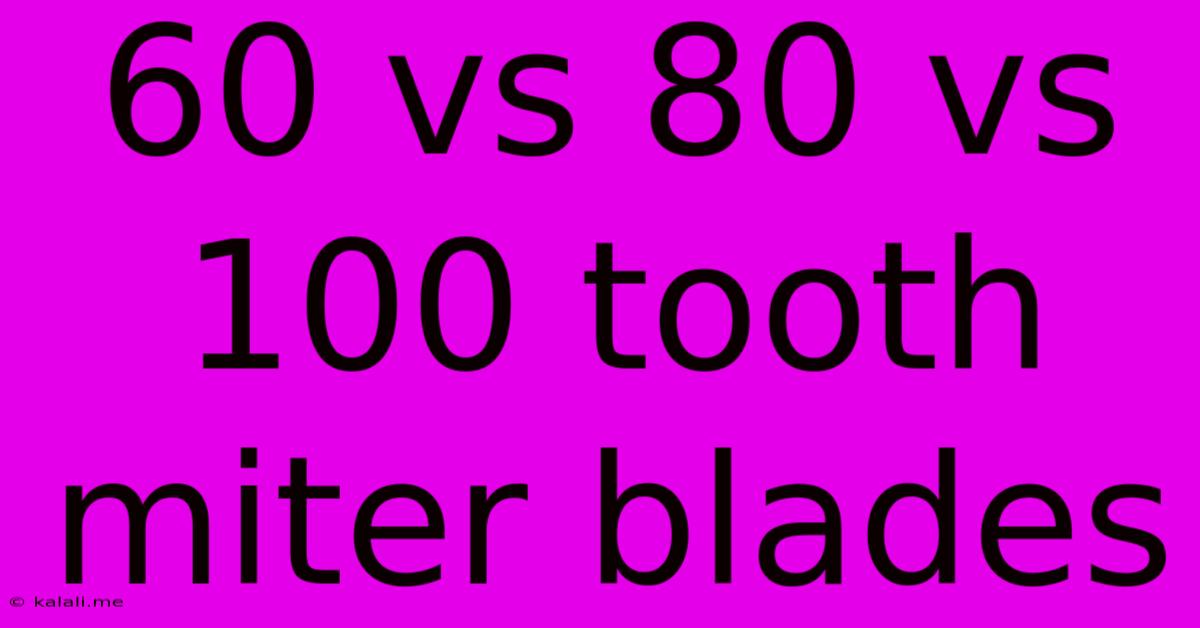60 Vs 80 Vs 100 Tooth Miter Blades
Kalali
Jun 06, 2025 · 3 min read

Table of Contents
60 vs 80 vs 100 Tooth Miter Blades: Choosing the Right Blade for Your Cuts
Choosing the right miter saw blade can significantly impact the quality of your cuts. The number of teeth directly affects the type of cut you achieve, influencing smoothness, precision, and the types of materials you can work with. This article will delve into the differences between 60, 80, and 100-tooth miter saw blades, helping you select the perfect blade for your woodworking projects.
Meta Description: Learn the key differences between 60, 80, and 100 tooth miter saw blades. This guide helps you choose the best blade for your woodworking needs, considering material type, cut quality, and desired finish.
Understanding Tooth Count and its Impact
The number of teeth on a miter saw blade directly correlates to the size of each tooth. More teeth mean smaller teeth, and vice-versa. This impacts several aspects of the cutting process:
-
Cut Quality: Blades with fewer teeth (like 60-tooth blades) have larger teeth, resulting in a rougher, more aggressive cut. This is ideal for ripping (cutting along the grain) and cutting hardwoods. Higher tooth counts (80 and 100) produce smoother, cleaner cuts, perfect for crosscutting (cutting against the grain) and delicate materials.
-
Material Type: The type of wood you're cutting heavily influences your blade choice. Hardwoods like oak and maple often benefit from a lower tooth count blade for a cleaner cut. Softer woods like pine can be handled effectively with both higher and lower tooth counts.
-
Cutting Speed: Fewer teeth generally mean faster cutting speeds, while more teeth result in slower cutting. This trade-off needs to be considered based on your project's urgency and the desired finish.
60-Tooth Miter Saw Blades: The Workhorse
A 60-tooth blade is often considered a general-purpose blade, capable of handling a wide range of materials and cuts. Its larger teeth provide aggressive cutting action, making it excellent for:
- Ripping hardwoods: Its larger gullets (spaces between teeth) effectively remove larger chips of wood.
- Faster cuts: The fewer teeth mean less resistance and a quicker cutting process.
- Demanding applications: Suitable for thicker stock and tougher materials.
80-Tooth Miter Saw Blades: The Versatile Option
The 80-tooth blade offers a balance between cutting speed and smoothness. It’s a versatile option that performs well in various scenarios:
- Crosscutting hardwoods and softwoods: Delivers cleaner cuts compared to a 60-tooth blade.
- Fine cuts: The smaller teeth create a smoother surface finish.
- Medium-density materials: Well-suited for materials that fall between hardwoods and softwoods.
100-Tooth Miter Saw Blades: Precision and Smoothness
A 100-tooth blade is the king of smooth cuts. Its extremely fine teeth minimize tear-out and produce an exceptionally clean finish. This makes it perfect for:
- Crosscutting softwoods: Ideal for achieving incredibly smooth cuts in softwoods like pine and fir.
- Fine woodworking: Essential for projects requiring a high-quality finish, like trim work or intricate moldings.
- Laminates and veneers: The minimal tear-out is crucial when working with delicate materials.
Choosing the Right Blade: A Summary
The best blade for your needs depends on the specific project. Consider these factors:
- Material: Hardwood? Softwood? Laminate?
- Cut type: Ripping or crosscutting?
- Desired finish: Rough and fast, or smooth and precise?
By carefully considering these aspects, you can select the appropriate blade – 60, 80, or 100 tooth – to ensure accurate and professional results in your woodworking projects. Remember to always consult your miter saw's manual for specific blade recommendations and safety guidelines.
Latest Posts
Latest Posts
-
Should We Round Up The Defects Of The Z Score
Jun 07, 2025
-
Is It Illegal To Honk At A Cop
Jun 07, 2025
-
Can You Start A Sentence With To
Jun 07, 2025
-
How Much Water Should Be In Ac Drip Pan
Jun 07, 2025
-
Why Is My Bathroom Sink Not Draining
Jun 07, 2025
Related Post
Thank you for visiting our website which covers about 60 Vs 80 Vs 100 Tooth Miter Blades . We hope the information provided has been useful to you. Feel free to contact us if you have any questions or need further assistance. See you next time and don't miss to bookmark.